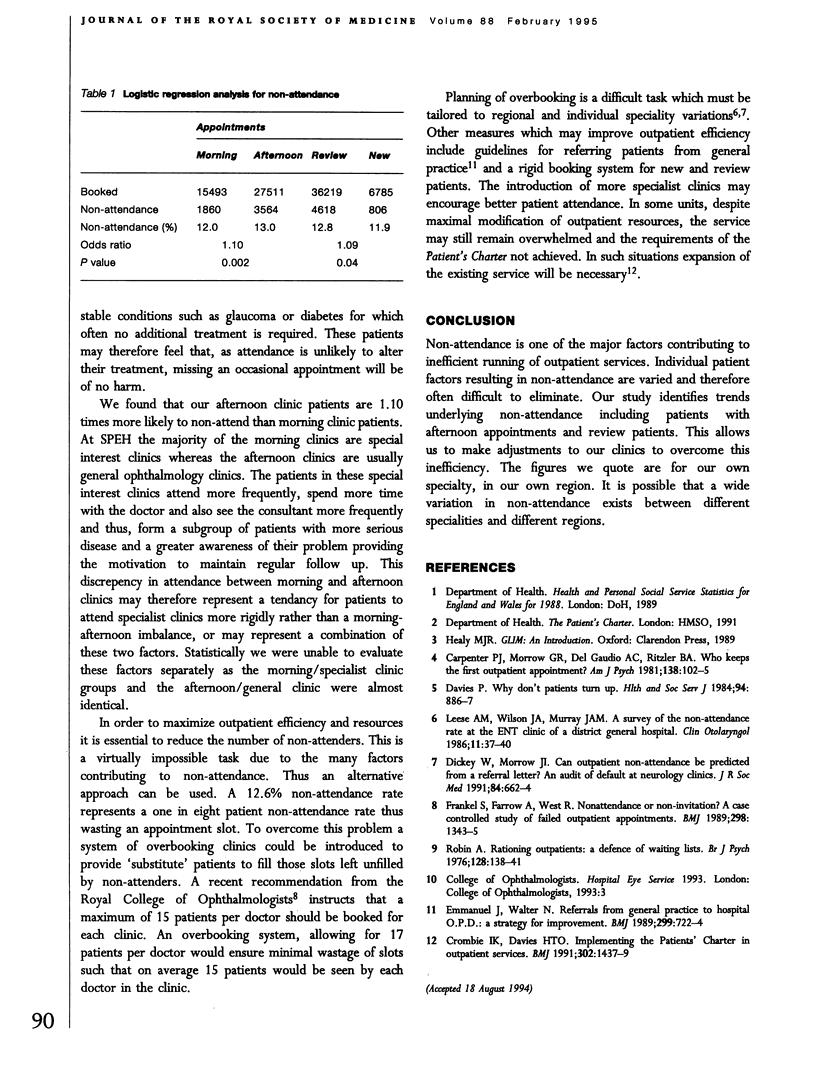Abstract
The object of the study was to establish the non-attendance rates in an ophthalmic outpatient department and any non-attendance patterns that may be useful in managing future outpatient resources. A detailed retrospective survey of monthly non-attendance rates was carried out in the outpatient department of a dedicated eye hospital over a 1 year period looking at differences in non-attendance between morning and afternoon clinics and new and review patients. A total of 43,004 scheduled outpatient appointments predominantly from the suburban population of the Merseyside region were made at St Paul's Eye Hospital from the 1 February 1990 to 31 January 1991. Five thousand four hundred and twenty-four appointments were missed giving an overall non-attendance rate of 12.6%. Non-attendance rates for morning and afternoon appointments were 12.0% and 13.0%, respectively: and for new and review patients, 11.9% and 12.8%, respectively. Logistic regression analysis showed that patients with afternoon appointments were on average 1.10 times more likely to non-attend than morning patients (P = 0.002), and that review patients were 1.09 times more likely to non-attend than new patients (P = 0.04). In order to maximize outpatient department efficiency, a reduction in non-attendance is essential. Establishing patterns for non-attendance provides us with a framework around which we can plan measures to compensate for outpatient non-attendance.
Full text
PDF


Selected References
These references are in PubMed. This may not be the complete list of references from this article.
- Carpenter P. J., Morrow G. R., Del Gaudio A. C., Ritzler B. A. Who keeps the first outpatient appointment? Am J Psychiatry. 1981 Jan;138(1):102–105. doi: 10.1176/ajp.138.1.102. [DOI] [PubMed] [Google Scholar]
- Crombie I. K., Davies H. T. Audit of outpatients: entering the loop. BMJ. 1991 Jun 15;302(6790):1437–1439. doi: 10.1136/bmj.302.6790.1437. [DOI] [PMC free article] [PubMed] [Google Scholar]
- Davies P. Why don't patients turn up? Health Soc Serv J. 1984 Jul 26;94(4907):886–887. [PubMed] [Google Scholar]
- Dickey W., Morrow J. I. Can outpatient non-attendance be predicted from the referral letter? An audit of default at neurology clinics. J R Soc Med. 1991 Nov;84(11):662–663. doi: 10.1177/014107689108401112. [DOI] [PMC free article] [PubMed] [Google Scholar]
- Emmanuel J., Walter N. Referrals from general practice to hospital outpatient departments: a strategy for improvement. BMJ. 1989 Sep 16;299(6701):722–724. doi: 10.1136/bmj.299.6701.722. [DOI] [PMC free article] [PubMed] [Google Scholar]
- Frankel S., Farrow A., West R. Non-attendance or non-invitation? A case-control study of failed outpatient appointments. BMJ. 1989 May 20;298(6684):1343–1345. doi: 10.1136/bmj.298.6684.1343. [DOI] [PMC free article] [PubMed] [Google Scholar]
- Leese A. M., Wilson J. A., Murray J. A. A survey of the non-attendance rate at the ENT clinic of a district general hospital. Clin Otolaryngol Allied Sci. 1986 Feb;11(1):37–40. doi: 10.1111/j.1365-2273.1986.tb00104.x. [DOI] [PubMed] [Google Scholar]


